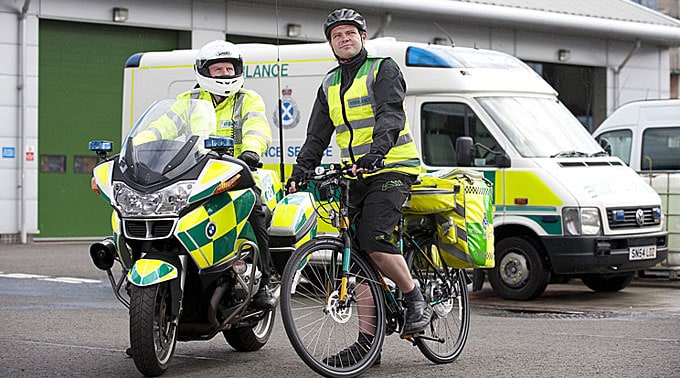
Who will treat you
As soon as we have enough information and we believe you need immediate medical treatment, we will send help.
There are a number of ways in which we respond, depending on the circumstances:
Emergency Ambulance
Frontline emergency ambulances with a crew of two, one of which will be a paramedic, respond to the majority of emergency calls. Ambulance Technicians and Paramedics are trained to deal with life threatening illnesses and injuries. We carry a full range of medical equipment on our ambulances, including electrocardiogram (ECG) machines to monitor a patient’s heart and defibrillators which can restart the heart if a patient goes into cardiac arrest.
Paramedic Response Unit (PRU)
Paramedic Response Units are normally crewed by a paramedic working on their own. They will go to patients by car or motorcycle and carry all of the life saving equipment needed in a medical emergency. In life threatening situations, they can provide a vital, fast response and they will be backed up by an emergency ambulance that can take you to hospital.
Special Operations Team (SORT)
Specialised Paramedics, Technicians and Logistics Staff trained to gain access and administer care for patients in hazardous or difficult environments and at the scene of major incidents. SORT also deploy to provide paramedical support for other agencies involved in potentially hazardous environments.
Community Paramedics
These are paramedics who have undertaken extra clinical training. They are able to thoroughly investigate a patient’s condition and situation and then make a qualified decision about the best way to progress their treatment. They often work with minor injuries units and out of hours doctor services and can refer patients to the most appropriate care if a visit to hospital is not required.
Air Ambulance
We operate two emergency helicopters and two fixed wing planes. They are often asked to assist at incidents where there may problems with inaccessible terrain or where a very fast evacuation to hospital is preferable to a journey by road ambulance.
Community First Responders
These are members of the community who have been trained to provide first aid and other medical skills while the ambulance is on its way to you. They are able to deliver treatments that are time critical, such as using a shock box in cardiac cases.
BASICS Responders (British Association of Immediate Care)
BASICS Responders are Doctor’s, Nurses and Paramedics who have received additional Pre-Hospital Emergency Training through BASICS Scotland. Each of the Responders are provided with a Sandpiper Medical/Trauma Response bag and access to a Defibrillator. Many Responders have also been issued with an Ambulance Service Airwave Radio and a Vehicle Locater System to allow contact and best resourcing via their Emergency Medical Dispatch Centre.
Paramedic Clinical Advisor
If the incident is not life threatening, you may be passed by telephone to one of our Paramedic Clinical Advisors, or to NHS 24, who will give you assistance or point you in the right direction for help.
Whatever your reason for calling us, the Emergency Medical Call Taker who answers your call will ensure that you receive the most appropriate response and liaise with other services and professionals where necessary.



